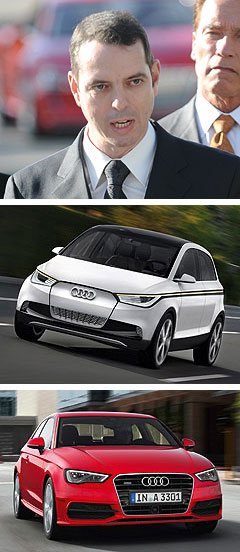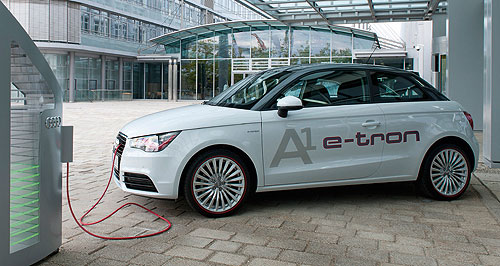Future models - Audi - A1 - e-tronSmall cars the limit for battery EVs: AudiPlug the gap: Audi beleives only vehicles less than four metres in length (like the A1) are suitable for purely battery-powered propulsion. Audi says even the A3 is borderline too large to be a pure battery electric vehicle14 Mar 2012 By BYRON MATHIOUDAKIS in GENEVA AUDI has revealed its move towards electrification will be dictated by the size of passenger vehicles. While every model from the A1 up to A8 limousine will be made available with some form of electric propulsion under the ‘e-tron’ nomenclature from next year, the company says only the smallest ones – including the upcoming A2 – will most probably be offered with pure battery electric vehicle (BEV) power. This means that while Audi’s best seller – the A3 – will most likely adopt full BEV electrification, it will use hybrid electric-motor assist and plug-in hybrid EV (PHEV) technology in the shorter term – with the latter already confirmed for limited production next year. Other PHEV models Audi has already confirmed will soon follow include the second-generation R8, A4 and Q7, but the A3 e-tron PHEV is expected to account for the lion’s share of electrification sales. Speaking with GoAuto at the Geneva motor show earlier this month, Audi AG electrification director Frank Van Meel, said factors such as real-world usage and range will limit the spread of BEVs of more than four metres in length until technology improves. Future battery developments may greatly increase the range of BEVs as lighter and more advanced materials make their way into small cars, but by then other solutions such as the hydrogen fuel cell vehicle may also become more viable in terms of price and infrastructural availability.  From top: Audi AG electrification director Frank Van Meel, Audi A2 concept, New Audi A3. From top: Audi AG electrification director Frank Van Meel, Audi A2 concept, New Audi A3.“With the electrification of our vehicles – from the customer standpoint – is how do I want to use my vehicle?” Mr Meel said. “If you look at the Audi ‘A’ and ‘B’ class vehicles (small segment upwards), they are more or less long-distance vehicles, for highway and long travels, so a purely electrical version of those vehicle platforms does not really make sense because then it destroys the idea of the vehicle itself. “So it means that, for those sorts of vehicles, we are pursuing the issue of plug-in hybrids (PHEV), because with a PHEV we can combine purely electrical driving in the city with the long-distance efficiency of an internal combustion engine. So by that you can use an Audi A8, A6 or A4 for long-distance travel, and on the other side you can run them on purely electrical around town. “The smaller the vehicle gets, the closer you come to ‘Mega City Vehicle’ (pure urban EV runabouts) usage, so we have the A1 e-tron as a principle of a concept car with a range extender just to make sure you don’t get stuck. (We did this) to find out if that is the right way… and so the smaller a vehicle is, the stronger the pure electrification side. “So for the (2011 Frankfurt show car) A2 concept we are currently discussing as a pure BEV, but we are also discussing other forms of electrification as well that we should be able to fit into that platform. “For a classic (small car) like the A3 it is more or less borderline, but that’s still the discussion that has to come from the customer side because we cannot decide for the customer how they are going to use their cars. “That’s what we are currently looking at as the borderline… and that is what we are looking at with the A2 as we bring that into mass production.” Still, Mr Meel revealed that many of the 20 hand-picked trial users of the A1 e-tron concept in Germany demand a vehicle that can also travel long distances, limiting the practical application of a BEV even in the company’s lightest and smallest production car currently available. “One of our key findings (with the A1 e-tron trial) is that people in the city – even though we are talking about a Mega City Vehicle – still want to have total usage of the vehicle. They don’t want to have anything compromised. They want to have full luggage capacity. They want to have the ability to carry more people when they go out at night or a sports event. Even if we are talking about an EV with short range, they want the full capabilities of a regular vehicle. “Another finding… is that most people charge at home, and that charging spots are still difficult to find, or are locked, or occupied – so from the customers point of view (using an EV) is still not as easy and convenient (as it should be). “On the other hand they really love the EV’s performance and quietness, and they get highly emotional about these.” Mr Meel said Audi would release the A1 e-tron trial findings later on this year, but the decision on whether Ingolstadt will employ the rotary range-extender in its smallest car has still not been decided. “(But) the range-extender principle is still a discussion that is ongoing because there are some customers that use the range-extender to go long distances, and that’s not what it is there for,” he added. “So there will be a discussion about range-extender versus PHEV, and which is the right combination with an internal combustion engine. These are interesting things that also correlate also with the availability of charging spots in the city, and so it is a very complex issue.” The A1 e-tron concept’s front wheels are driven solely by an electric motor for up to 50km before a unique rotary internal combustion petrol engine connected to the battery pack (and not the wheels) fires up to recharge the 270-volt lithium-ion batteries for approximately another 200km of range. With a plug-in outlet incorporated behind the grille badge, charging time is rated at about eight hours while the 75kW/240Nm output is on a par with today’s 1.2TSI model.  Read more6th of March 2012  Geneva show: Audi unveils third-generation A3Lighter, more efficient Audi A3 hatch takes to the stand at Geneva2nd of March 2012  Audi makes billionsBooming large-car sales and Chinese market send Audi profits soaring22nd of November 2011  Audi plugs into hybridsPlug-in hybrids first up for Audi as German car-maker strives to meet CO2 laws22nd of November 2011  First drive: Next A3 Sportback set to plug inAudi’s electric hatch will hit the road, just not in the guise you see here21st of November 2011  First drive: Audi A1 e-tron a revolution too far?Audi’s rotary range extender an interesting but noisy insight into future EV options3rd of November 2011  Plug-in Audi A1 e-tron not past trial stageAudi hands over the keys to 20 A1 e-tron prototypes for fleet trials in Munich24th of October 2011  Audi confirms hybrids for Oz in 2013Hybrid A6 and A8 sedans on way Down Under as Audi unveils 2020 electrification plan20th of September 2011  New Audi A2 not before 2015Advanced propulsion, material and connectivity tech to converge on future Audi A27th of September 2011  Frankfurt show: New Audi A2 revealedAudi goes for BMW’s i3 jugular with its all-electric A2 premium compact conceptA1 pricing
Motor industry news |
Click to shareAudi modelsResearch Audi A1 pricing
Motor industry news |
















Facebook Twitter Instagram